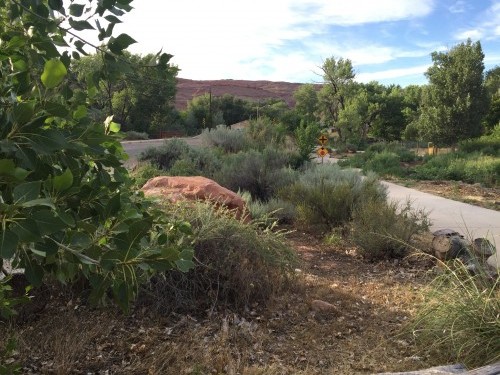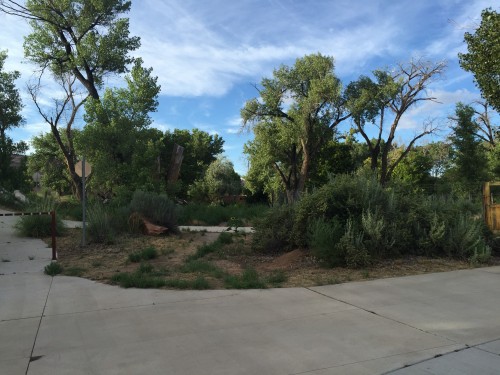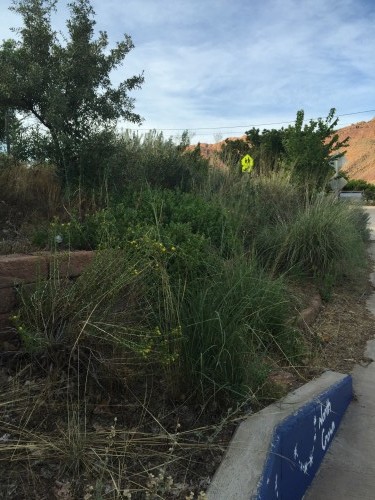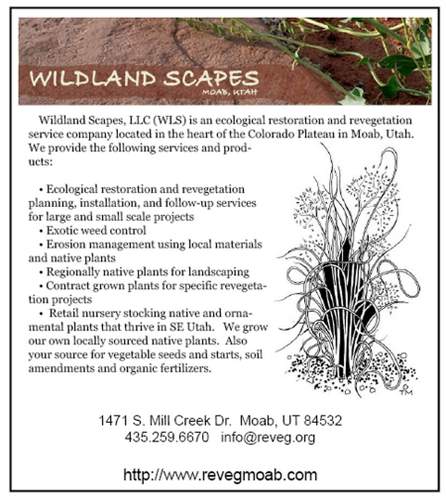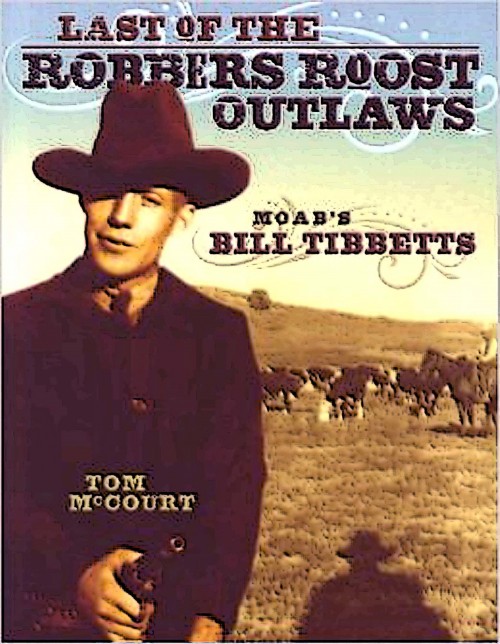I grow plants in the desert for planting in yards and in unirrigated revegetation project areas in SE and Central Utah. Almost every day from February through October I talk with people about how to water plants – how much, how often, and how it really is possible to kill a plant with too much water.
I know The Zephyr is usually not a venue for plant and gardening advice – and don’t worry, this won’t turn into a regular gardening column – but this topic seems relevant to people all over the west right now. Effective irrigation is relevant to Moab today, with the ground water study finally getting started, and also to areas throughout the West facing drought yet again this year.
LEARNING BY DOING
In 2002 I worked on a roadside project in Moab along 400 E near Mill Creek next to the the new location of the Youth Garden Project at the old Shafer Home. With the help of a local chapter of the Utah Native Plant Society we planted an area approximately the size of a typical residential lot in Moab at the time (approximately 1/5 of an acre) with native plants on a drip system. We also installed a water meter to track the irrigation used in that area during the plant establishment period. From April to October 2002 11,100 gallons (or 1,570 per month) irrigated the newly installed plants. Based on City of Moab residential water use figures (subtracting the average water used in residential service in a winter month from the average water used in spring summer and fall months) most residences used an average of 126,175 gallons, or 18,025 gallons per month, on their landscapes during that same period. That is over 10 TIMES the water used to establish plants at 400 East that year. Keep in mind much more water is needed to establish plants than to keep established plants healthy and happy, so the water use over time at the 400 E site reduced.
As of July 2015 most of the plants are still there – though the site is in need of some weeding. It has not been irrigated in at least 4 years, possibly longer. It is possible to grow plants other than Russian thistle, kochia, cheat grass and goatheads in Moab without irrigating them forever.
Obviously there are a huge number of variables that can’t be tracked in this kind of comparison, but it still shows the immense amount of water used to water landscapes in Moab that could be reduced without killing plants. In 2002 I believed native plants in landscapes were the way to reduce this water use. Over the past 13 years I have grown to better understand irrigation needs of plants, native and otherwise, and have had 100s of conversations with people about how they irrigate their yards. While I still have a strong personal preference for native (and food producing) plants I am convinced today that over half the water used to irrigate residential and commercial landscaping could be saved by simply watering more efficiently, without ripping out landscapes and installing all natives.
THE RIGHT PLANT in THE RIGHT PLACE
The idea to put the right plants in the right place, native or not, based on available water and maintenance is a simple one, but it is very often overlooked. When the right plant is in the right place, care for it becomes much simpler. Recently, as our retail outlet has developed, I have grown to better appreciate the non native ornamental landscape plants that are used so often in Moab and throughout the West. Some of these plants use much more water than natives, but many use about the same amount. In all cases though, plant the right plant in the right place and watering and maintenance become much easier. It is impossible to grow a healthy full shade plant in direct sun. Plants that need lots of water can’t be grown well with plants that need very little water. Plantings need to be arranged not only with access to sunlight in mind, but with access to irrigation or natural water as well.
THAT’S ALL WELL AND GOOD, BUT HOW DOES IT TRANSLATE ON THE GROUND:
A few years ago I moved into a new-to-us house that we renovated. The renovation process destroyed what little yard was left, save an old cedar tree and a few small shade trees out front. None of these trees had been watered for years, but they were alive. The properties around us have been more recently built up, so much of the rainfall on our house stays in our yard rather than running down the gutter into the creek. I suspect this fortuitous water harvesting is a big part of why these trees were still alive when we moved in.
It took a couple of years living in the house for me to decide what I wanted to plant. I decided that the plants in my yard had to be edible or medicinal, not just ornamental. In some ways, this rule is kind of cheating since nearly every plant fits this description if you research the plants. But I really was looking to make the yard full of edible plants – after all if I was going to water them they may as well produce food too.
And so my yard needs irrigation in addition to the water we gain from rain off our roof. To grow food crops in Moab and have those plants produce with regularity I need to irrigate, especially when it gets hot. In the monsoon season, and this year all spring, I get a lot of help from my roof and my flagstone areas and keep having to turn my timer off. But to ensure food production I irrigate shrubs, grapes and strawberries 2 to 3 times a week in the hottest months. My veggie garden drip irrigation runs nearly every day in June through August. And the fruit and shade trees get a deep soak once a week. Next door at our old house we have a small lawn – and that also gets watered 3 x a week in July and August – much less in spring and fall.
HELL STRIPS – IT IS POSSIBLE TO GROW PLANTS WITH NO IRRIGATION AT ALL
I also have a front strip between the sidewalk and the street since I live in downtown Moab – some people call this the hell strip. You can tell why if you look at many of these spaces around Moab, or other towns and cities. A combination of foxtails, thistle and goatheads, with some gravel is the most common “planting” in these areas. Little micro hells.
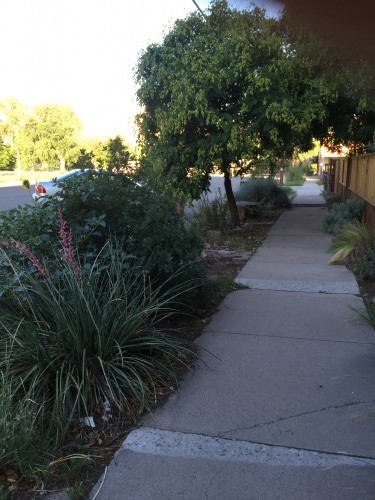
The Hell Strip. 100 N. Planted about 10 years ago. Watered once a month or less. Stopped watering in 2013
In my hell strip I planted the few desert plants I can grow in my heavy clay soils – a cliffrose, desert willow, a few globemallow, rough mules ears, a gambel oak and red yucca. And I have not watered this space in over 2 years (though I have left the drip irrigation in place in in case I want to some year). And I barely have to weed it now that the native plants have established themselves. I suspect the solar pumping action of the roadway brings some water to the roots of these plants, but I provide no other water to them. Hell strips have huge potential, but they definitely take a little planning and time to cultivate them into something more than gravel and goatheads
ORGANIZED CHAOS – DRIP IRRIGATION
Drip irrigation evolved over a very very long time. In more recent history, Israel is often cited as the home of modern drip irrigation parts and systems and Netafim was the first company to focus exclusively on drip irrigation and how to efficiently get water consistently to plants through pipes at a low flow and pressure.
The reason that drip irrigation is so efficient is that it gets water in measured amounts to the roots of the plants without exposing the water to the air where it can evaporate quickly. And drip applies the water slowly – which allows the water to soak more deeply into the ground fully saturating the root zone of the plant with the smallest amount of water possible. Flood irrigation tends to be a bit uneven, and requires a great deal of grading to get water in the quantities you want where you want it. Overhead sprinklers apply water evenly over an area but water is lost to evaporation. Also plant roots are not necessarily evenly spread throughout the landscape, and shrubs and trees intercept overhead spray irrigation making coverage spotty.
All irrigation methods have their place – but in arid environments drip irrigation is by far the most efficient way to effectively distribute water to landscapes. It does, though, require some careful planning otherwise the system can become a bit of a spaghetti bowl of lines running everywhere.
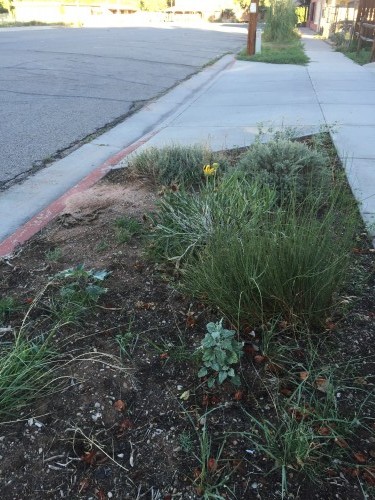
100 N. Planted 3 years ago. Watered by hand once a week for one summer. Now no water. Still a little weedy but getting better.
THE IMPORTANCE OF IIRIGATION ZONES
When I design an irrigation system, whether for a new or established landcapes, I think in watering zones. The zones can overlap or intersect to some degree, but each zone is watered differently. At my house now we have 4 zones – the tree line, the trees and shrubs near the house (mostly in shade), the vegetable garden, and the lawn. We also have irrigation to our hell strip, but this line is no longer used or hooked up to the timer.
To start with, I put all the trees on one irrigation line that is separate from ALL other irrigation. This allows for trees to be watered deeply and infrequently independently of the other plants in the landscape (lawn, shrubs or otherwise). Once established most trees only need water once a week in the hottest months – but they need upwards of 250 gallons in order to fully saturate the root zone, so this line runs for at least 4 to 8 hours each time it runs. In spring and fall this line only runs once every 2 to 3 weeks depending on how hot it is.
Next the shrubs are watered together – and since my property is tiny and I have higher water plants and lower plants on this line I control the amount of water to these plants by using different emitter sizes. Some shrubs like lilacs or mock orange might have 2 or 6 gallon per hour emitters, whereas others like fernbush and sage can do well watered using a 1 or 2 gallon emitter. This line runs once every 3 or 4 days in summer for just a couple hours, and once every 7 to 10 days in the spring and fall. Just as with trees, established shrubs need enough water each time they are irrigated to fully saturate the root zone. A full sized mesic shrub may need 20 to 50 gallons to accomplish this, whereas a more xeric shrub may only need 20 gallons if it is impossible to simply water it less frequently.
My vegetable garden is on its own line since in the hottest months it needs irrigation approximately every other day, sometimes daily. In spring and fall I irrigate the vegetables as needed, sometimes only once or twice a week (other than when germinating seeds), but in July and August when it is around 100F I often irrigate one hour every morning. The other benefit to drip in the garden (while a bit of a pain when turning in amendments) is that water is never applied to plant leaves which can help prevent fungus and disease, and makes it easier to use organic pesticides in the rare times I need them. There are approximately 60 emitters in my garden ranging from 1 gallon per hour to 6 gallons per hour. Last time I calculated I was applying about 100 gallons to my vegetable garden each time I irrigate.
The lawn is definitely its own zone. My dwarf tall fescue lawn is irrigated with overhead sprinklers that run once a week in spring and fall, and 3 times a week in July and August. I use low flow sprayers (about 1 to 2 gallons a minute as opposed to 8 to 20 gallons a minute of most standard pop up sprinklers) which means I water for 60 minutes when I water. With 6 sprinkler heads that means I am apply between 360 and 720 gallons to the small lawn every time I water it. If I had a buffalo blue grama lawn I would water once or twice a week in summer to keep it green, and once every 1 to 2 weeks in Spring and Fall.
The hell strip in front of my house is now what I might call a no water/revegetation zone at a property farther out of town. In this area I have left the drip irrigation I installed years ago, but it is no longer used.
If I had a larger property I might have a line for forbs and grasses (other than lawns). These may have their own irrigation line, or may be planted where they can access some of the water used to irrigate trees and shrubs. However if they are water needing plants they may need water up to every other day in small quantities and in this case they must have their own drip line otherwise they just won’t make it.
NOTHING NEEDS WATER EVERY DAY
As you can see, there is very little that needs water daily, even in Moab’s hottest months. I have received calls about trees dying, and after some discussion often I find out that the tree (and surrounding lawn) is being watered twice a day every day for 20 minutes. Usually this is because the landscaper left the timer that way 4 years ago when the lawn was first installed. Or I’m told there are mushrooms and algae at the base of the tree. When I point out that the lawn AND tree would be healthier if the lawn was watered no more than 3 times a week in summer, and the tree given a deep soaking once a week, the response is usually shock and a pronouncement that of course the lawn would die if watered that way! There is nothing, other than maybe my tomato plant in July, that needs water every day. Even in Moab.
Effective irrigation not only saves water, but also results in healthy plants – native or otherwise. And it really is that easy, except that human beings have a hard time thinking like plants. After all, humans need water every day, several times a day. Especially in hot dry climates. Plants, on the other hand can take deep long drinks and be fine for days and days.
A FEW RESOURCES FOR MORE INFORMATION:
While this webpage was designed for Arizona, it is the best interactive site I have found. The site is easy to navigate, and the information is presented in a format targeting all water users. In 1999 a number of partners including the cities of Mesa, Phoenix, Scottsdale, Tempe, Peoria, Chandler, Glendale, Avondale, Surprise, Fountain Hills and Queen Creek. Additional partners include the Arizona Municipal Water Users Association, Global Water Resources, EPCOR Water and Salt River Project developed a great resource about how to conserve water. The website is full of all kinds of suggestions for more effectively using water. It makes sense that communities in Arizona started working on this 15 years ago – with a population expected to grow well past natural water resources available in the state the only way to have enough water for people is to use it carefully.
USU extension has a huge range of resources specific to Utah. This is a small list of a few of them: http://extension.usu.edu/files/publications/factsheet/pub__975158.pdf
There is a sprinkler testing guide for many cities and towns in Utah at: https://cwel.usu.edu/htm/water-check-program.
This one is for Moab: http://digitalcommons.usu.edu/cgi/viewcontent.cgi?article=1335&context=extension_curall
Vegetable watering in Utah: http://extension.usu.edu/files/publications/publication/ENGR_BIE_WM-37.pdf
Tree and shrub watering in Utah: https://extension.usu.edu/files/publications/publication/HG-523.pdf
Kara Dohrenwend is a regular contributor to the Zephyr. She lives in Moab, Utah.
To read the PDF version of this article, click here.
To comment, scroll to the bottom of the page.
Don’t forget the Zephyr ads! All links are hot!


